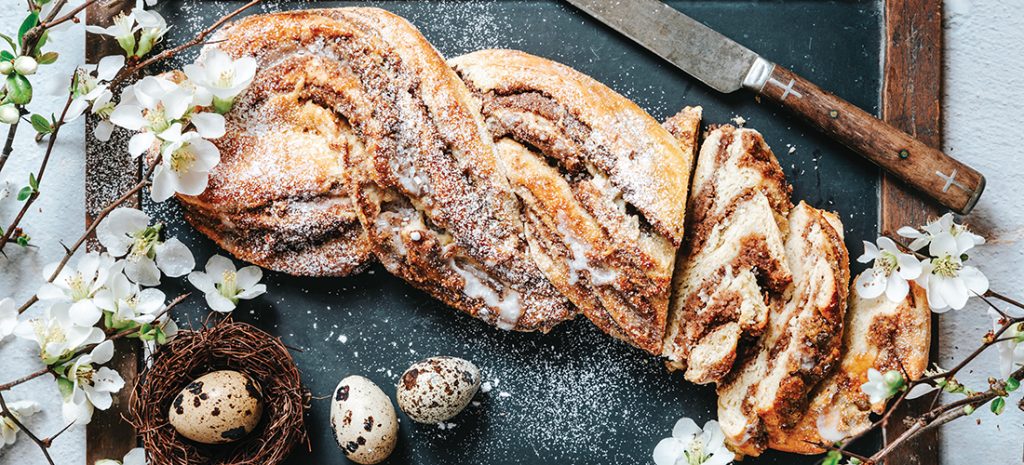Focus on Food

Mademoiselle Brioche
A sweet bread for Easter
Story and Photograph by Rose Shewey
If “brioche” conjures up images of burger buns, and little else, have you even lived yet?
Sure, brioche can be a party girl. She makes fabulous burger and sandwich bread, no doubt, but that’s just scratching the surface of what brioche is capable of. Yes, she can be your flip-flop-wearing, tank top-sporting drinking buddy, but if you ever had chocolate-glazed diplomats, you know she can also be your sophisticated wedding date in a lacy dress with kitten heels.
Or, as I am about to show you, brioche can effortlessly turn into your folksy, linen-trousered best friend with dangling earrings, one that is always full of surprises. Brioche is truly multifaceted but rarely ordinary.
For those of you who don’t geek out over baked goods, allow me to explain: Brioche is a delicate, buttery yeast bread (technically, it is a Viennoiserie), similar to everyday yeast breads, but picture a downy cloud made of fine-spun cotton and you have yourself some epic brioche. It also happens to be one of the easier bread recipes to make — if you own some sort of kneading gadget, which I do not.
I stubbornly hand-knead my dough. Nothing is quite as meditative and grounding as using your bare hands to make bread; feeling the texture transform between your fingers from powdery, gooey and slippery to a satisfyingly malleable shape. Making dough is the grown-up equivalent of a toddler’s sensory bin, if ever I have seen one. Bonus points if your dough later doubles in size, which it hopefully will, and you have passed the halfway mark to a feathery brioche, whichever shape or form you decide to process it into.
With Easter, or Ostara, on the horizon — you know, that time of the year that marks the awakening of the earth and colors the land in lovely shades of pastel — many cultures celebrate with the tradition of braided yeast bread. The interpretation of its symbolism is wide-ranging and differs significantly, depending on the Kulturkreis. For me, it’s simply a family tradition that brings back memories of my grandma’s kitchen; the sweet perfume of freshly scraped vanilla beans, the earthy scent of fermenting yeast and us kids sticking our fingers into the sugar-lemon glaze bowl, which ultimately got us banished from the room. We didn’t call it brioche then; I didn’t connect the dots until later on, when I went on my own baking journey, and of all the things brioche can be, the Easter braid will forever be my favorite.
Mocha Hazelnut Brioche Braid
(Makes 1 braided loaf)
(Basic dough recipe adapted from
Bouchon Bakery)
For the dough:
270 grams all-purpose flour
6 grams instant yeast
30 grams granulated sugar
7 grams salt
130 grams eggs (roughly 3 medium sized eggs)
45 grams milk
120 grams unsalted butter, cut into 1/2 inch cubes
For the filling:
150 grams finely ground hazelnuts
30 grams sugar
30 grams chocolate spread
5 grams cinnamon
50 grams grated apple
60 grams brewed coffee
8 grams freshly squeezed lemon juice
Place flour and yeast in a large mixing bowl and whisk to combine. Add remaining ingredients except for the butter and mix for 5 minutes by hand, or with the help of a stand mixer with dough hook. Continue kneading for 30 minutes while slowly adding in small chunks of butter. Fully incorporate each chunk of butter before you add the next. The dough will be slightly sticky at this point; remove it from the bowl (use a scraper if needed) and place it on a lightly floured surface. Pat, stretch and fold the dough, then place it back in the bowl, cover and allow to rest for 1 hour at room temperature. Repeat the pat, stretch and fold before moving the dough to the refrigerator and chilling overnight.
Combine all ingredients for the mocha hazelnut filling and set aside. Take the dough out of the fridge and set on a lightly floured surface. Roll out the dough to form a rectangle (about 30×45 centimeters) and cover evenly with the mocha hazelnut filling. Roll up the dough tightly lengthwise, then cut it in half lengthwise and entwine both strings to form a braid. Move your braid to a baking sheet and allow to rest at room temperature for 30-45 minutes. Preheat oven to 325F, apply egg wash, if desired, and bake for 30-35 minutes or until braid turns a light golden color. . PS
German native Rose Shewey is a food stylist and food photographer. To see more of her work visit her website, suessholz.com.
